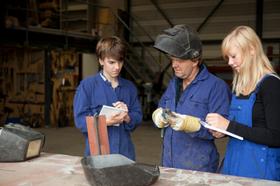Jobs are ready and waiting in the United States today. Unfortunately, there are not enough skilled workers ready to fill those posts, according to many in the business sector. With that mantra in mind, the state of education in the U.S. appears to be facing a major overhaul. The focus is shifting from preparing all students for a four-year postsecondary education to providing at least some of those students with the skills necessary to find lucrative careers shortly after high school. Introducing technical education, revamped and ready for the 21st-century global market.
Skills Shortage in the U.S.
The training gap has been one that has slowly evolved over recent decades. Generations past were able to land good jobs right after high school, in manufacturing and other industries that benefitted from high school classes in technical subjects that were once known as “shop” courses. However, the workplace began to change, with manufacturing jobs requiring new skills as technology took over the assembly line. Unfortunately, the public school curriculum did not change with the time, and “shop” classes now considered irrelevant gradually became obsolete.
My San Antonio hinted at a change that is currently beginning to sweep high schools nationwide, by highlighting a portion of President Obama’s recent State of the Union Address. In his speech, the President stated that in order to compete on a global level with countries like Germany, high schools in America would need to do a better job of preparing high school students for technical positions that do not require a four-year degree. The President suggested that while this might still mean a path to a two-year degree program, some high schools might be able to prepare students more efficiently by working with community colleges to provide students with necessary training while they are still in high school.
My San Antonio cites statistics from a National Tooling and Machining Association survey that showed as many as 91 percent of manufacturing businesses in this county could be facing moderate to severe problems finding skilled workers today. With high schools focusing more on core curriculum subjects like math, science, reading, writing, and social studies, rather than technical subjects that are workplace focused, students are no longer graduating from high school ready to hit the workforce at full speed. Even students heading to community college often must take remedial coursework before they are ready to begin the technical training they need to land in-demand jobs.
This video discusses the viability of vocational training.
Employers, High Schools, Community Colleges Team Up
To fill the employment gap that has been slowly broadening, high schools, community colleges, and local businesses have begun teaming up across the country to provide relevant technical training students can actually use after they finish their schooling. In some cases, this may involve courses taken on the high school campus, while other hybrid programs combine high school and community college coursework throughout the high school years. Still, others might present a smooth transition between high school and community college so that students can seamlessly continue to pursue their career goals through their postsecondary education.
Check out the ideas that are being introduced across the country to accommodate the country’s growing workplace needs:
Texas Leading Charge for Skills Training
Texas lawmakers are beginning to take a serious look at bills to expand technical training programs in high school and beyond, according to a report at The Statesman. One of those bills, carried by Senate Education Committee Chairman Dan Patrick (R-Houston), requires additional science courses for graduation but also offers greater flexibility in how those requirements could be met. Instead of core science subjects like physics, students would have the option of taking a class in diesel mechanics or other subjects relevant to a particular field.
The Texas bills are currently being pushed by a business coalition in the state that includes members like the Texas Chemical Council. Other members include representatives of construction, manufacturing, and oil and gas industries in the state. Members assert that the 4x4 education plan instituted by the state legislature in 2007 dramatically decreased the amount of technical training available in Texas high schools. That plan requires students to complete four years of math, science, English, and social studies for graduation, which left few electives available for technical courses.
“Everyone realizes something has to change,” Hector Rivero, president of the Texas Chemical Council, told The Statesman. “We have to create more flexibility, more choice, without taking away opportunities for kids to go to college.”
This video reports on technical training in the Louisa County Schools in Mineral, Virginia.
South Carolina Schools Add Technical Training
South Carolina is another state currently working on ways to add technical training to the high school curriculum, according to the Enquirer Herald. Schools in both York and Clover are bringing new training programs in manufacturing to their high school campuses this fall, as the schools strive to meet an employment need in their immediate communities. The program will focus on classes in mechatronics, which combines mechanical skills with computer technology and programming.
Missouri Schools Note Rise in Demand for Technical Training
Missouri has found that students in the state’s high schools are taking advantage of skills training offered by the schools in higher numbers than ever before. The St. Louis Post-Dispatch reports that 63 percent of high school students in the state participated in some sort of technical training course during the 2011-2012 school year, which was an increase of three percent over the previous year. If the trend continues, it could prompt this state to find new options in technical training for students as well.
While most educators and business leaders agree a four-year degree is still the best choice for a recession-proof career path, technical training is finding a new voice today. As more high schools work to prepare students for the 21st-century workforce, technical classes may bring “shop” to a whole new level in high schools around the country.
Questions? Contact us on Facebook. @publicschoolreview














